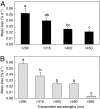Dual role of lignin in plant litter decomposition in terrestrial ecosystems
- PMID: 20176940
- PMCID: PMC2842047
- DOI: 10.1073/pnas.0909396107
Dual role of lignin in plant litter decomposition in terrestrial ecosystems
Abstract
Plant litter decomposition is a critical step in the formation of soil organic matter, the mineralization of organic nutrients, and the carbon balance in terrestrial ecosystems. Biotic decomposition in mesic ecosystems is generally negatively correlated with the concentration of lignin, a group of complex aromatic polymers present in plant cell walls that is recalcitrant to enzymatic degradation and serves as a structural barrier impeding microbial access to labile carbon compounds. Although photochemical mineralization of carbon has recently been shown to be important in semiarid ecosystems, litter chemistry controls on photodegradative losses are not understood. We evaluated the importance of litter chemistry on photodegradation of grass litter and cellulose substrates with varying levels of lignin [cellulose-lignin (CL) substrates] under field conditions. Using wavelength-specific light attenuation filters, we found that light-driven mass loss was promoted by both UV and visible radiation. The spectral dependence of photodegradation correlated with the absorption spectrum of lignin but not of cellulose. Field incubations demonstrated that increasing lignin concentration reduced biotic decomposition, as expected, but linearly increased photodegradation. In addition, lignin content in CL substrates consistently decreased in photodegradative incubations. We conclude that lignin has a dual role affecting litter decomposition, depending on the dominant driver (biotic or abiotic) controlling carbon turnover. Under photodegradative conditions, lignin is preferentially degraded because it acts as an effective light-absorbing compound over a wide range of wavelengths. This mechanistic understanding of the role of lignin in plant litter decomposition will allow for more accurate predictions of carbon dynamics in terrestrial ecosystems.
Conflict of interest statement
The authors declare no conflict of interest.
Figures




Similar articles
-
Photodegradation alleviates the lignin bottleneck for carbon turnover in terrestrial ecosystems.Proc Natl Acad Sci U S A. 2016 Apr 19;113(16):4392-7. doi: 10.1073/pnas.1516157113. Epub 2016 Apr 4. Proc Natl Acad Sci U S A. 2016. PMID: 27044070 Free PMC article.
-
Sunlight Doubles Aboveground Carbon Loss in a Seasonally Dry Woodland in Patagonia.Curr Biol. 2020 Aug 17;30(16):3243-3251.e3. doi: 10.1016/j.cub.2020.06.005. Epub 2020 Jul 2. Curr Biol. 2020. PMID: 32619488
-
Dose-responses for solar radiation exposure reveal high sensitivity of microbial decomposition to changes in plant litter quality that occur during photodegradation.New Phytol. 2022 Sep;235(5):2022-2033. doi: 10.1111/nph.18253. Epub 2022 Jun 8. New Phytol. 2022. PMID: 35579884
-
Photodegradation in terrestrial ecosystems.New Phytol. 2024 Nov;244(3):769-785. doi: 10.1111/nph.20105. Epub 2024 Sep 11. New Phytol. 2024. PMID: 39262084 Review.
-
Decoupling the direct and indirect effects of climate on plant litter decomposition: Accounting for stress-induced modifications in plant chemistry.Glob Chang Biol. 2018 Apr;24(4):1428-1451. doi: 10.1111/gcb.13923. Epub 2018 Jan 28. Glob Chang Biol. 2018. PMID: 28986956 Review.
Cited by
-
Lignin: characterization of a multifaceted crop component.ScientificWorldJournal. 2013 Nov 14;2013:436517. doi: 10.1155/2013/436517. ScientificWorldJournal. 2013. PMID: 24348159 Free PMC article. Review.
-
Dynamics of soil nitrogen fractions and their relationship with soil microbial communities in two forest species of northern China.PLoS One. 2018 May 24;13(5):e0196567. doi: 10.1371/journal.pone.0196567. eCollection 2018. PLoS One. 2018. PMID: 29795562 Free PMC article.
-
Changes in soil carbon fractions and enzyme activities under different vegetation types of the northern Loess Plateau.Ecol Evol. 2020 Sep 29;10(21):12211-12223. doi: 10.1002/ece3.6852. eCollection 2020 Nov. Ecol Evol. 2020. PMID: 33209282 Free PMC article.
-
C/N ratio drives soil actinobacterial cellobiohydrolase gene diversity.Appl Environ Microbiol. 2015 May 1;81(9):3016-28. doi: 10.1128/AEM.00067-15. Epub 2015 Feb 20. Appl Environ Microbiol. 2015. PMID: 25710367 Free PMC article.
-
Latitudinal variation in ambient UV-B radiation is an important determinant of Lolium perenne forage production, quality, and digestibility.J Exp Bot. 2013 May;64(8):2193-204. doi: 10.1093/jxb/ert077. Epub 2013 Apr 11. J Exp Bot. 2013. PMID: 23580749 Free PMC article.
References
-
- Boerjan W, Ralph J, Baucher M. Lignin biosynthesis. Annu Rev Plant Biol. 2003;54:519–546. - PubMed
-
- Swift MJ, Heal OW, Anderson JM. Decomposition in Terrestrial Ecosystems. Berkeley, CA: University of California Press; 1979.
-
- Berg B, Johansson M-B, Meentemeyer V. Litter decomposition in a transect of Norway spruce forests: Substrate quality and climate control. Can J Res. 2000;30:1136–1147.
-
- Pauly M, Keegstra K. Cell-wall carbohydrates and their modification as a resource for biofuels. Plant J. 2008;54:559–568. - PubMed
-
- Potter CS, Klooster SA. Global model estimates of carbon and nitrogen storage in litter and soil pools: Response to changes in vegetation quality and biomass allocation. Tellus B Chem Phys Meteorol. 1997;49:1–17.
Publication types
MeSH terms
Substances
LinkOut - more resources
Full Text Sources
Other Literature Sources
Molecular Biology Databases

